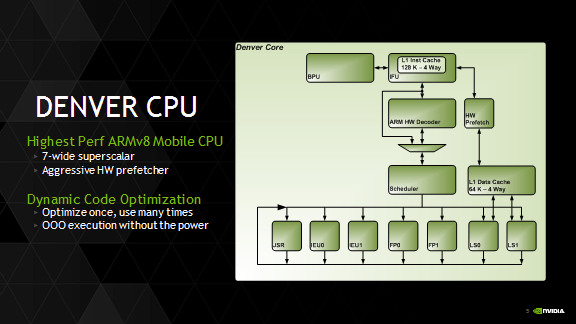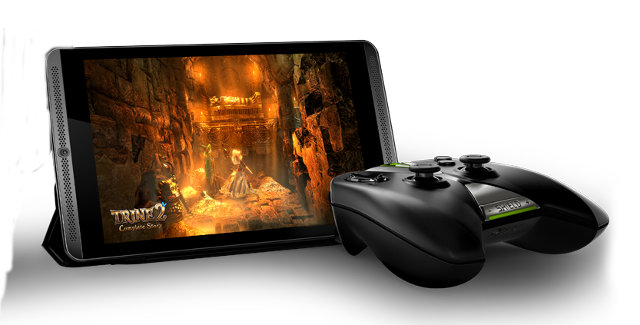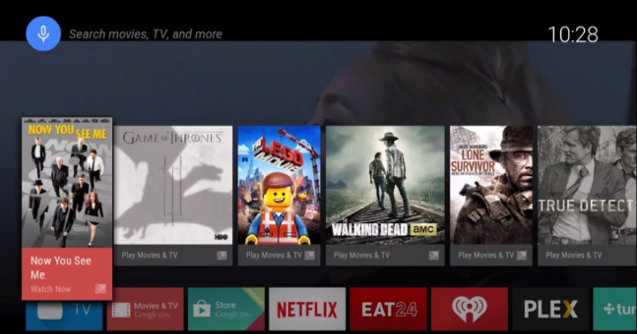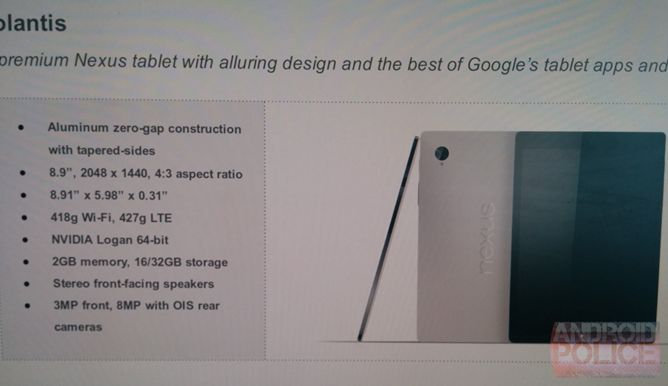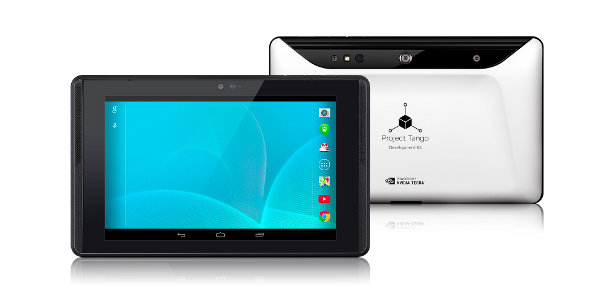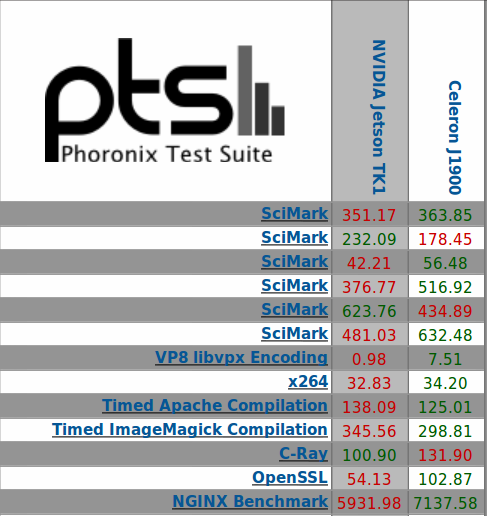The 32-bit version of Nvidia Tegra K1 have generally received good reviews in terms of performance, especially GPU performance, and the company has also provided good developer’s documentation and Linux support, including open source drivers for the Kepler GPU (GK20A) found in the SoC. But as initially announced, Tegra K1 with also get a 64-bit ARM version codenamed “Denver”, and Nvidia provided more details at Hotchips conference. The 64-bit Tegra K1 will still feature a 192-core Kepler GPU, but replace the four ARM Cortex A15 cores found in the 32-bit version, by two ARMv8 “Project Denver” cores custom-designed by Nvidia. The multi-core performance of the dual core 64-bit Tegra K1 @ 2.5 GHz may end up being equivalent to the quad core 32-bit Tegra K1 @ 2.1 GHz, but the single core performance will be much better thanks to a a 7-way superscalar microarchitecture (vs 3-way for Cortex A15), as […]
Some Projects on Nvidia Jetson TK1 Development Board: Nintendo Emulator, USB3 Webcam, and Robotics
Nvidia Jetson TK1 is a development board powered by the company’s Tegra K1 quado core Cortex A15 processor, and especially a Kepler GPU that allows for OpenGL 4.4. It has shipped to developers around April/May, and some of them have showcased their projects, or tested some hardware. Dolphin Emulator on Nvidia Jetson TK1 Dolphin is an emulator for Nintendo GameCube and Wii console that supports full HD (1080p) rendering, and run on Android, Linux and Mac OS, and there’s also an Alpha version for Android. Ryan Houdek (Sonicadvance1), one of Dolphin’s developers, has leveraged Kepler’s OpenGL support via Nvidia’s GPU drivers, to port the emulator to the platform running on Ubuntu, but it should work as well on Tegra K1 hardware running Android such as XiaoMi MiiPad tablet. You can watch Mario Kart: Double Dash demo running at full speed on the Nvidia board below. According to the developer, such […]
Nvidia Announces Tegra K1 based Shield Tablet with Game Controller and Stylus
After the Shield game console, Nvidia has now announced the Shield Tablet powered by Nvidia Tegra K1 quad core processor, and specifically designed for gamer with a kickstand to adjust the inclination of the 8″ display, and a Wi-Fi Direct game controller with low latency, including a built-in stereo headphone jack and microphone. Shield tablet specifications: SoC – NVIDIA Tegra K1 quad core Cortex A15 @ 2.2 GHz processor with a 192 core Kepler GPU System Memory – 2GB RAM Storage – 32 GB (WiFi+4G LTE) or 16 GB (WiFi-only), and micro SD slot Display – 8″ multi-touch display; 1920×1200 resolution Video Output – 1x mini HDMI output Audio I/O – Front facing stereo speakers, dual bass reflex port with built-in microphone, 3.5 mm stereo headphone jack with microphone support Connectivity – Wireless 802.11n 2×2 Mimo 2.4 GHz and 5 GHz Wi-Fi, Bluetooth 4.0 LE and GPS / GLONASS Cellular […]
Google Formally Launches Android TV. Android TV Set-Top Boxes and TVs to be Available in H2 2014
After Android L for mobile devices, and Android Wear for wearables, Google also announced Android for your television at Google I/O 2014, and after definitely killing “Google TV”, renaming it to “Google Services for Smart TV”, the company went for the obvious and called it “Android TV”, which will get messy with all the Chinese “Android TV” boxes that do not run “Android TV” but simply “Android”… Google apparently used an Android TV reference platform (ADT-1) based on Nvidia Tegra 4 K1 at I/O to showcase their latest implementation of Android the the living room. I’ve embedded the video of the demo below, but the key part of the demo can be summarized as follows: Android TV’s “TV Input Framework” can overlay notifications and other data on top of various video sources such as HDMI, TV tuners, and IP TV receivers Voice control demo (with smartphone) with requests such as: […]
HTC / Google Nexus 9 To Feature Nvidia Tegra K1 Dual Core 64-bit ARMv8 Processor
ARMv8 (64-bit ARM) architecture has been seen in servers, and announced in mobile SoCs, but, putting aside some Apple products, we have yet to see any consumer products based on the latest ARM architecture. But this will change soon, as HTC Volantis, which could become Google Nexus 9 based on the picture leaked via Android Police, will feature an “Nvidia Logan 64-bit” SoC, which can only be a Tegra K1 dual core ARMv8 SoC announced at CES 2014. HTC Volantis / Nexus 9 specifications: SoC – NVIDIA Tegra K1 (logan) dual core 64-bit Processor System Memory – 2GB RAM Storage – 16/32GB internal storage Display – 8.9″ Display at 2048×1440 (281ppi) Camera – 8MP main camera with OIS, 3MP front facing camera Audio – Stereo front-facing speakers Dimensions – 22.63×15.19×0.79cm Weight – 418g, or 427g with LTE The assumption is that it will be released as the latest major release […]
Google Unveils Project Tango Tablet Development Kit Powered by Nvidia Tegra K1 SoC
Earlier this year, Google ATAP (Advanced Technology and Products) showcased project tango phone prototype, capable of generating 3D maps in real-time thanks to cameras, motion sensors, and two Movidius Myriad 1 Mobile Vision processors paired with a Qualcomm Snapdragon 800 application processor, and since March, they’ve already sent a few hundred samples to developers. Google has now announced another development kit, this time a tablet powered by Nvidia Tegra K1 quad core SoC. Tango tablet has the following hardware specifications: SoC – Nvidia Tegra K1 quad core Cortex A15 with Kepler GPU System Memory – 4GB RAM Storage – 128GB Display – 7″ screen Connectivity – WiFi, BlueTooth Low Energy, and 4G LTE Camera – 120 deg. wide angle front camera, 4MP rear camera, and motion tracking camera Sensors – Integrated depth sensing The tablet will run Google’s KitKat Android operating system, and support features such as OpenGL 4.4 thanks to the […]
ARM Cortex A15/A17 SoCs Comparison – Nvidia Tegra K1 vs Samsung Exynos 5422 vs Rockchip RK3288 vs AllWinner A80
We’re now starting to get quite a few players with ARM Cortex A15 cores on the market, as well as some with ARM Cortex A17. So a comparison table of different quad and octa SoCs might be a useful thing to do. I’ve put aside SoCs such as HiSilicon K3V3, and OMAP5, and focused on the four latest processors: Nvidia Tegra K1 (32-bit), Samsung Exynos 5422, Rockchip RK3288 and AllWinner A80. I haven’t included Mediatek MT6595 and Qualcomm SnapDragon 805, because the two companies mainly focus on smartphones and tablets (although it appears to be slowly changing for Qualcomm), documentation is usually difficult or impossible to find, and in the case of Qualcomm they use their own ARMv7 Krait cores. I’ve highlighted some features in green, in case a particular SoC appears to have an edge. Rockchip RK3288 AllWinner A80 Nvidia Tegra K1 Samsung Exynos 5422 CPU 4x ARM Cortex-A17 […]
Nvidia Tegra K1 CPU/FPU Performance is Comparable to Intel Celeron “Bay Trail-D” J1900 SoC
Nvidia Jetson TK1 development board powered by Nvidia Tegra K1 quad core ARM Cortex A15 processor and a 192-core Kepler GPU has started shipping, and some people have already received theirs, including Michael Larabel (Phoronix) who ran some benchmarks on the board that comes pre-loaded with Ubuntu 14.04 LTS. We already had some benchmarks comparing Tegra K1 to ARM peers on Android, but it’s the first time Linux benchmarks are available. The benchmarks seems to only involve CPU and FPU, and probably not the GPU at this point, but the results are still interesting, and Michael also pointed links comparing Nvidia Tegra K1 development board performance to some Intel Core i5 based PCs, as well as a platform based on an Intel Celeron J1900, a quad core processor part of Bay Trail Desktop family. The later is most interesting as we compare systems with similar power requirements. Nvidia Tegra K1 […]


